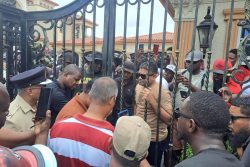Guyana’s season of fear has had an unnecessary, though not totally unexpected extension wrought by Sunday’s well-planned, well-executed prison breakout where fire was used as a diversionary measure. Add to the mix the fact that this took place in the middle of a heavily populated urban area and was followed by chaos—the excellent work of the security forces notwithstanding—and one cannot be faulted for assuming that this season is likely to continue for some time to come.
The lessons from the 2002 Republic Day prison break were that when inmates take desperate measures to escape they are unlikely to hole up somewhere waiting to be caught. Those who do are usually the first to be captured. The planning that would have gone into the escape scenario would have included where they would go, how they would settle scores if any and how they would obtain money and materials to remain a step ahead of the authorities.
The crime spree which followed the 2002 jailbreak gave a clear indication of why that infamous quintet had broken out and their boldness sorely tested the security forces of the day. There was no doubt too that other criminal elements took advantage of the then trying security situation.
Two years later, the Disciplined Services Commission Report made a number of recommendations for improving prisons around Guyana. These included increasing the number of trained warders to deal with the growing number of inmates, and the capacity of the Mazaruni Prison to reduce overcrowding – especially by high-risk prisoners – at the Georgetown Prison.
The Mazaruni Prison, which like the other major facilities in Georgetown and New Amsterdam, was built by the British, was completed in 1845 and at that point was designated a maximum-security prison. It is important to note that around the world, maximum security prisons are intended to house those inmates who commit violent crimes and are deemed likely to want to escape. These facilities have to be extremely secure, manned by experienced warders, subject to constant monitoring and tend to be placed in remote areas.
Of the three major prisons, Mazaruni offered the best prospects for maximum security—the British knew what they were about—but was never maintained as such. As a result it became less secure and was the scene of a massive riot in 1997. Fire was also the choice of weapon of those prisoners and some four dormitories were burnt to the ground. A proactive government would have sought to remedy this situation, but the Jagan administration did itself and this country no favours by following the already set pattern of housing condemned prisoners and lifers, many of whom had been found guilty of committing heinous crimes at the Camp Street facility in Georgetown and at New Amsterdam. The Jagdeo and Ramotar governments did exactly the same thing.
There has therefore long been a mingling of populations: murderers with pickpockets and rapists with fraudsters and so on. Even though they may not have been in the same cell blocks, sharing of the same facility would have made communication, intimidation and recruitment (for further promotion of criminal enterprise) possible. This would also have affected rehabilitation as the same programmes would not be effective for differing categories of inmates.
To make matters worse, the remand facilities were/are also general ones with a mélange of prisoners sharing the same space.
This was and continues to be a recipe for disaster and as sure as night follows day, disasters have taken place, each worse than the other. Over the years, there has been a series of violent inmate-on-inmate attacks in the New Amsterdam and Georgetown prisons, the most recent being just last month at New Amsterdam, which resulted in the loss of life.
In sum, the scenario which rendered the Georgetown Prison useless had been building for a long time, a huge contributory factor being the extended neglect of the entire security system. That prison warders can still be recruited given the conditions under which they are forced to work, including the woefully inadequate salaries they are paid, is an indication of nothing more than the employment situation in the country.
There is a lot that needs to be changed and done differently going forward and the road taken will reveal whether the nation’s security is really being taken seriously.







